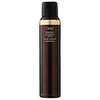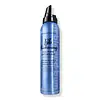What's inside
What's inside
 Key Ingredients
Key Ingredients

 Benefits
Benefits

 Concerns
Concerns

 Ingredients Side-by-side
Ingredients Side-by-side

Water
Skin ConditioningVp/Va Copolymer
Isobutane
Propane
Cetearyl Alcohol
EmollientPEG-40 Hydrogenated Castor Oil
EmulsifyingOleth-20
CleansingParfum
MaskingPhenoxyethanol
PreservativePolyquaternium-4
Laureth-4
EmulsifyingSodium C14-16 Olefin Sulfonate
CleansingStearyl Alcohol
EmollientCetrimonium Bromide
AntimicrobialPanthenol
Skin ConditioningEthylhexylglycerin
Skin ConditioningSilicone Quaternium-3
Glycerin
HumectantHelianthus Annuus Seed Oil
EmollientTocopheryl Acetate
AntioxidantTrideceth-12
EmulsifyingBenzophenone-4
UV AbsorberSodium Benzoate
MaskingSodium Hydroxide
BufferingPolyurethane-14
Alcohol Denat.
AntimicrobialSilicone Quaternium-16
Skin ConditioningCitrullus Lanatus Fruit Extract
Skin ConditioningLitchi Chinensis Fruit Extract
Skin ConditioningLeontopodium Alpinum Flower/Leaf Extract
Skin ConditioningUndeceth-11
EmollientAmp-Acrylates Copolymer
Tocopherol
AntioxidantAminomethyl Propanol
BufferingButyloctanol
HumectantUndeceth-5
EmulsifyingStyrax Benzoin Resin Extract
MaskingCitric Acid
BufferingPotassium Sorbate
PreservativeAcetic Acid
BufferingIodopropynyl Butylcarbamate
PreservativeLimonene
PerfumingHexyl Cinnamal
PerfumingLinalool
PerfumingCitral
PerfumingWater, Vp/Va Copolymer, Isobutane, Propane, Cetearyl Alcohol, PEG-40 Hydrogenated Castor Oil, Oleth-20, Parfum, Phenoxyethanol, Polyquaternium-4, Laureth-4, Sodium C14-16 Olefin Sulfonate, Stearyl Alcohol, Cetrimonium Bromide, Panthenol, Ethylhexylglycerin, Silicone Quaternium-3, Glycerin, Helianthus Annuus Seed Oil, Tocopheryl Acetate, Trideceth-12, Benzophenone-4, Sodium Benzoate, Sodium Hydroxide, Polyurethane-14, Alcohol Denat., Silicone Quaternium-16, Citrullus Lanatus Fruit Extract, Litchi Chinensis Fruit Extract, Leontopodium Alpinum Flower/Leaf Extract, Undeceth-11, Amp-Acrylates Copolymer, Tocopherol, Aminomethyl Propanol, Butyloctanol, Undeceth-5, Styrax Benzoin Resin Extract, Citric Acid, Potassium Sorbate, Acetic Acid, Iodopropynyl Butylcarbamate, Limonene, Hexyl Cinnamal, Linalool, Citral
Water
Skin ConditioningIsobutane
Propane
Polyquaternium-11
Hydrolyzed Soy Protein
HumectantWheat Amino Acids
Skin ConditioningHydrolyzed Amaranth Protein
Skin ConditioningPEG-12 Dimethicone
Skin ConditioningSalix Nigra Bark Extract
Skin ProtectingPanthenol
Skin ConditioningSodium Lactate
BufferingEthylhexylglycerin
Skin ConditioningSodium PCA
HumectantAspartic Acid
MaskingPCA
HumectantArginine
MaskingAlanine
MaskingSerine
MaskingValine
MaskingProline
Skin ConditioningThreonine
Isoleucine
Skin ConditioningHistidine
HumectantPhenylalanine
MaskingCetrimonium Chloride
AntimicrobialTocopherol
AntioxidantVp/Va Copolymer
Laureth-4
EmulsifyingPEG-40 Hydrogenated Castor Oil
EmulsifyingPolyquaternium-4
Glycine
BufferingEthylhexyl Methoxycinnamate
UV AbsorberSodium Hydroxide
BufferingParfum
MaskingLinalool
PerfumingLimonene
PerfumingCitral
PerfumingCitronellol
PerfumingBenzyl Benzoate
AntimicrobialHydroxycitronellal
PerfumingCoumarin
PerfumingHexyl Cinnamal
PerfumingBHT
AntioxidantDisodium EDTA
Potassium Sorbate
PreservativePhenoxyethanol
PreservativeWater, Isobutane, Propane, Polyquaternium-11, Hydrolyzed Soy Protein, Wheat Amino Acids, Hydrolyzed Amaranth Protein, PEG-12 Dimethicone, Salix Nigra Bark Extract, Panthenol, Sodium Lactate, Ethylhexylglycerin, Sodium PCA, Aspartic Acid, PCA, Arginine, Alanine, Serine, Valine, Proline, Threonine, Isoleucine, Histidine, Phenylalanine, Cetrimonium Chloride, Tocopherol, Vp/Va Copolymer, Laureth-4, PEG-40 Hydrogenated Castor Oil, Polyquaternium-4, Glycine, Ethylhexyl Methoxycinnamate, Sodium Hydroxide, Parfum, Linalool, Limonene, Citral, Citronellol, Benzyl Benzoate, Hydroxycitronellal, Coumarin, Hexyl Cinnamal, BHT, Disodium EDTA, Potassium Sorbate, Phenoxyethanol
Ingredients Explained
These ingredients are found in both products.
Ingredients higher up in an ingredient list are typically present in a larger amount.
Citral is a fragrance and used to add a lemon-like scent to products. It is both naturally found in plants and created synthetically. In plants, it is commonly occurring in lemon myrtle, lemongrass, lemon tea-tree, lemon verbena, and other citruses.
The EU mandates Citral be listed separately as a fragrance. It is a known allergen and may cause contact dermatitis. Citral can also used as a masking ingredient.
The term 'fragrance' is not regulated in many countries. In many cases, it is up to the brand to define this term. For instance, many brands choose to label themselves as "fragrance-free" because they are not using synthetic fragrances. However, their products may still contain ingredients such as essential oils that are considered a fragrance.
The term 'citral' is a collective term for two geometric isomers: geranial/Citral A and neral/Citral B.
Learn more about CitralEthylhexylglycerin (we can't pronounce this either) is commonly used as a preservative and skin softener. It is derived from glyceryl.
You might see Ethylhexylglycerin often paired with other preservatives such as phenoxyethanol. Ethylhexylglycerin has been found to increase the effectiveness of these other preservatives.
Hexyl Cinnamal is a fragrance ingredient with a similar scent to jasmine. It can be naturally found in chamomile essential oil.
This ingredient is a known EU allergen and may sensitize the skin. The EU requires this ingredient to be listed separately on an ingredients list.
Hexyl Cinnamal is not water soluble but is soluble in oils.
Learn more about Hexyl CinnamalWe don't have a description for Isobutane yet.
Laureth-4 is created by reacting ethylene oxide with Lauryl Alcohol. It is a surfactant and emulsifier.
Surfactants reduce the surface tension of ingredients so they can mix better. Emulsifiers prevent ingredients such as oil and water from separating.
Limonene is a fragrance that adds scent and taste to a formulation.
It's found in the peel oil of citrus fruits and other plants such as lavender and eucalyptus. The scent of limonene is generally described as "sweet citrus".
Limonene acts as an antioxidant, meaning it helps neutralize free radicals.
When exposed to air, oxidized limonene may sensitize the skin. Because of this, limonene is often avoided by people with sensitive skin.
The term 'fragrance' is not regulated in many countries. In many cases, it is up to the brand to define this term. For instance, many brands choose to label themselves as "fragrance-free" because they are not using synthetic fragrances. However, their products may still contain ingredients such as essential oils that are considered a fragrance.
Learn more about LimoneneLinalool is a fragrance and helps add scent to products. It's derived from common plants such as cinnamon, mint, citrus, and lavender.
Like Limonene, this ingredient oxidizes when exposed to air. Oxidized linalool can cause allergies and skin sensitivity.
This ingredient has a scent that is floral, spicy tropical, and citrus-like.
Learn more about LinaloolPanthenol is a common ingredient that helps hydrate and soothe the skin. It is found naturally in our skin and hair.
There are two forms of panthenol: D and L.
D-panthenol is also known as dexpanthenol. Most cosmetics use dexpanthenol or a mixture of D and L-panthenol.
Panthenol is famous due to its ability to go deeper into the skin's layers. Using this ingredient has numerous pros (and no cons):
Like hyaluronic acid, panthenol is a humectant. Humectants are able to bind and hold large amounts of water to keep skin hydrated.
This ingredient works well for wound healing. It works by increasing tissue in the wound and helps close open wounds.
Once oxidized, panthenol converts to pantothenic acid. Panthothenic acid is found in all living cells.
This ingredient is also referred to as pro-vitamin B5.
Learn more about PanthenolParfum is a catch-all term for an ingredient or more that is used to give a scent to products.
Also called "fragrance", this ingredient can be a blend of hundreds of chemicals or plant oils. This means every product with "fragrance" or "parfum" in the ingredients list is a different mixture.
For instance, Habanolide is a proprietary trade name for a specific aroma chemical. When used as a fragrance ingredient in cosmetics, most aroma chemicals fall under the broad labeling category of “FRAGRANCE” or “PARFUM” according to EU and US regulations.
The term 'parfum' or 'fragrance' is not regulated in many countries. In many cases, it is up to the brand to define this term.
For instance, many brands choose to label themselves as "fragrance-free" because they are not using synthetic fragrances. However, their products may still contain ingredients such as essential oils that are considered a fragrance by INCI standards.
One example is Calendula flower extract. Calendula is an essential oil that still imparts a scent or 'fragrance'.
Depending on the blend, the ingredients in the mixture can cause allergies and sensitivities on the skin. Some ingredients that are known EU allergens include linalool and citronellol.
Parfum can also be used to mask or cover an unpleasant scent.
The bottom line is: not all fragrances/parfum/ingredients are created equally. If you are worried about fragrances, we recommend taking a closer look at an ingredient. And of course, we always recommend speaking with a professional.
Learn more about ParfumPeg-40 Hydrogenated Castor Oil is derived from castor oil and polyethylene glycol (PEG). It is used as a emollient and emulsifier.
As an emulsifier, it helps prevent ingredients from separating. It also helps make the other ingredients more soluble; it is often used to solubilize fragrances. This increases spreadability and elongates shelf life in a product.
Emollients help soothe and soften the skin. They do this by creating a protective film on your skin. This barrier helps trap moisture and keeps your skin hydrated. Emollients may be effective at treating dry or itchy skin.
This ingredient may or may not be vegan, depending on the source.
Peg-40 Hydrogenated Castor Oil may not be fungal-acne safe. We recommend speaking with a professional if you have any questions or concerns.
Learn more about PEG-40 Hydrogenated Castor OilPhenoxyethanol is a preservative that has germicide, antimicrobial, and aromatic properties. Studies show that phenoxyethanol can prevent microbial growth. By itself, it has a scent that is similar to that of a rose.
It's often used in formulations along with Caprylyl Glycol to preserve the shelf life of products.
We don't have a description for Polyquaternium-4 yet.
Potassium Sorbate is a preservative used to prevent yeast and mold in products. It is commonly found in both cosmetic and food products.
This ingredient comes from potassium salt derived from sorbic acid. Sorbic acid is a natural antibiotic and effective against fungus.
Both potassium sorbate and sorbic acid can be found in baked goods, cheeses, dried meats, dried fruit, ice cream, pickles, wine, yogurt, and more.
You'll often find this ingredient used with other preservatives.
Learn more about Potassium SorbatePropane is a gas derived from petroleum and natural gas. It is used as a propellant.
This ingredient is most commonly used in shaving cream, hair products, and makeup.
Sodium Hydroxide is also known as lye or caustic soda. It is used to adjust the pH of products; many ingredients require a specific pH to be effective.
In small amounts, sodium hydroxide is considered safe to use. However, large amounts may cause chemical burns due to its high alkaline.
Your skin has a natural pH and acid mantle. This acid mantle helps prevent harmful bacteria from breaking through. The acid mantle also helps keep your skin hydrated.
"Alkaline" refers to a high pH level. A low pH level would be considered acidic.
Learn more about Sodium HydroxideTocopherol (also known as Vitamin E) is a common antioxidant used to help protect the skin from free-radicals and strengthen the skin barrier. It's also fat soluble - this means our skin is great at absorbing it.
Vitamin E also helps keep your natural skin lipids healthy. Your lipid skin barrier naturally consists of lipids, ceramides, and fatty acids. Vitamin E offers extra protection for your skin’s lipid barrier, keeping your skin healthy and nourished.
Another benefit is a bit of UV protection. Vitamin E helps reduce the damage caused by UVB rays. (It should not replace your sunscreen). Combining it with Vitamin C can decrease sunburned cells and hyperpigmentation after UV exposure.
You might have noticed Vitamin E + C often paired together. This is because it is great at stabilizing Vitamin C. Using the two together helps increase the effectiveness of both ingredients.
There are often claims that Vitamin E can reduce/prevent scarring, but these claims haven't been confirmed by scientific research.
Learn more about TocopherolWe don't have a description for Vp/Va Copolymer yet.
Water. It's the most common cosmetic ingredient of all. You'll usually see it at the top of ingredient lists, meaning that it makes up the largest part of the product.
So why is it so popular? Water most often acts as a solvent - this means that it helps dissolve other ingredients into the formulation.
You'll also recognize water as that liquid we all need to stay alive. If you see this, drink a glass of water. Stay hydrated!
Learn more about Water